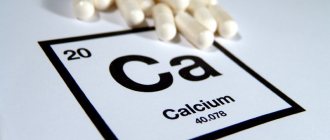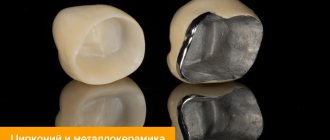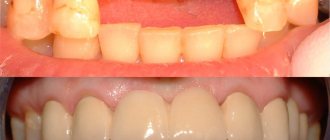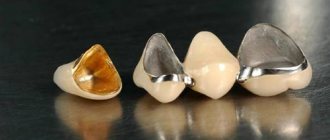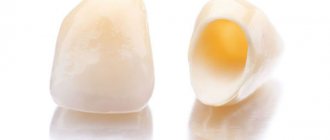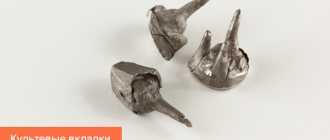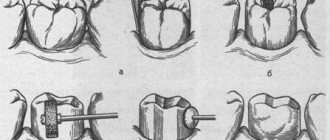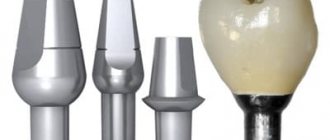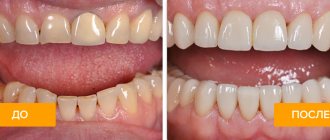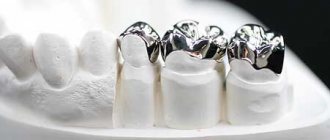Reasons for chipping ceramics in metal-ceramic structures
At the junction of the metal frame of the denture and the ceramic coating, strong stresses often arise, which in stressful situations lead to the formation of cracks, chips or spalls in the ceramics.
The main reasons for ceramic chipping are:
- Mismatch between the thermal expansion coefficients of ceramics and the metal alloy from which the frame is made.
- Unreasonable choice of metal ceramics as a material for a fixed prosthesis in some patients (for example, those suffering from bruxism).
- If the intermediate part of a metal-ceramic bridge is too long, the frame of which is made of precious alloys (which have lower rigidity than non-precious alloys), chewing loads on it can lead to chipping of the veneer.
- Incorrect tooth preparation, for example, insufficient taper, can lead to stress in the framework of the metal-ceramic crown and subsequent chipping of the veneer.
- Chips often occur when performing orthopedic work (especially large-scale ones) without an articulator and a facebow.
- When fixing a metal-ceramic prosthesis with excessively thick cement, or when foreign bodies get between the tooth stump and the crown.
- Chips may be a consequence of incorrect modeling of the metal-ceramic frame of the future prosthesis:
- insufficient height of the frame, which necessitates the layering of an excessive amount of ceramics - unmodeled tooth relief - non-compliance with the technology of mechanical and chemical processing of the metal frame - holes in the metal frame, which technicians close with ceramics. Subsequently, after cementing the crowns, tension arises here, since the cement presses evenly on all walls and later a chip forms in this place and rapid decementing of the structure.
If you have a problem similar to that described in this article, be sure to contact our specialists. Don't diagnose yourself!
Why you should call us now:
- We will answer all your questions in 3 minutes
- Free consultation
- The average work experience of doctors is 12 years
- Convenient location of clinics
Single contact phone number: +7
Make an appointment
- The cause of chipping may be stress in the ceramics or metal frame, resulting from non-compliance with technological rules for working with ceramics:
- overheating of the metal during firing of ceramics - violation of temperature relationships during successive firing and cooling of ceramics - violation of the rules for working with ceramic masses offered by manufacturers - non-compliance with ceramic processing technology.
- Careless or careless handling of the patient with prosthetic metal-ceramic structures. The fragility of ceramics under inadequate loads, and less often during sudden temperature changes, should be taken into account. We also recommend that you read the article about installing ceramic crowns at 32Dent dentistry.
Technological aspects of metal ceramics
In the process of manufacturing metal-ceramic structures, there are a number of key points that deserve special attention.
Tooth preparation for metal ceramics.
- The tooth must be prepared (ground) with a ledge at the gum level.
- The total thickness of the metal frame and the ceramic mass covering it is about 1.5 mm. As a result, if the tooth is ground without a ledge, we get the edge of the crown hanging over the gum and pressing on it. The crown presses against the blood vessels and a “bruise” forms. The metal frame comes into direct contact with the gum, and metal ions cause it to darken.
- In the case of preparation with a shoulder, the edge of the metal-ceramic crown rests on the hard tissues of the tooth without injuring the mucous membrane. This technology is quite labor-intensive, and its implementation requires a modern dental unit and, of course, the qualifications of a doctor and dental technician.
The intermediate part of the metal-ceramic bridge prosthesis should also not put pressure on the mucous membrane (gum), otherwise bedsores may form. Of course, in those places where it is visible, you have to make a compromise, but in any case the touch should be very gentle. And if food gets into a place where there is a loose seal, it will be much easier to remove it from there than in the case of the “full contact” option.
Many doctors “sin” by depulping (removing the nerve of the tooth) even healthy teeth under metal-ceramics, which is not always justified, since modern technologies make it possible in many cases to avoid this procedure. Depulped (dead) teeth cannot resist infection and often have to be re-treated. In addition, a pulpless tooth becomes more fragile and can collapse under a heavy metal-ceramic structure.
Manufacturing and fixation of a partial zirconium denture
High-strength ceramic materials are becoming increasingly in demand in dental practice. Metal-ceramic crowns are essentially two-layer restorations that are supported by a metal coping or similar substructure and lined with a more aesthetic material, ceramic. The introduction of zirconium dioxide has made it possible to replace metal caps with more aesthetic and equally durable analogues, and although zirconium itself is more opaque, the use of more transparent feldspathic ceramics in the structure of partial dentures for veneering such restorations helps to easily solve this problem.
According to one systematic review of publications from 2006 to 2013, which analyzed 67 clinical studies and 4663 cases of metal-ceramic crowns and 9434 cases of all-ceramic single restorations, it was possible to establish the following: the five-year success rate of metal-ceramic crowns is 95.7%, leucite-reinforced and lithium disilicate – 96.6%, and lined with zircon – 91.2%. Ceramic chips occurred with almost the same frequency in both metal-ceramic crowns and those with a zirconium base, and the rate of such complications over 5 years did not exceed 2.6%. However, fracture of the zirconium base was extremely rare - only 0.4% of cases over 5 years. At the same time, loss of retention of zirconium structures was observed in almost 4.7% of situations. On the other hand, tooth fractures and their iatrogenic devitalization were most often observed when using metal-ceramic structures, and amounted to 1.2 – 1.8%.
From a biological point of view, all-ceramic crowns perform better than their metal-ceramic counterparts, as indicated by the higher rates of fracture of abutment teeth with loss of vitality when using structures supported by a metal cap. The high strength of zirconia has generated considerable interest in its use as a load-bearing structure in the manufacture of fixed partial dentures.
One systematic review, which included 40 clinical studies and analysis of 1796 metal-ceramic and 1110 all-ceramic bridge structures, found that the survival rate of such restorations was 94.4% and 90.4%, respectively. That is, no significant differences were observed between the 5-year success rates of different types of restorations. Fractures of bridge-like restorations made of glass-ceramics (8.0%) and ceramics based on silicon-aluminum compounds (12.9%) occurred significantly more often compared to metal-ceramic (0.6%) and densely sintered zirconium structures (1.9%). Thus, it is clear that the incidence of ceramic chipping and loss of retention was observed more frequently in zircon-supported restorations than in metal-supported restorations.
Clinical trials with zirconia have shown that, despite a relatively low rate of cap fracture, these restorations are generally more susceptible to porcelain chipping than metal-ceramic bridge restorations. Further development of zirconium materials has helped improve their color rendering and transparency, which has taken them to a new aesthetic level. In addition, CAD/CAM technology has advanced significantly, allowing laboratories to fabricate monolithic restorations without the need for subsequent layering of feldspathic ceramics. Monolithic zirconium oxide has become a popular material for the manufacture of crowns for distal teeth and as part of fixed bridge structures. However, the volume of necessary research remains insufficient to draw definitive and reasoned conclusions.
A recent clinical study comparing the performance of CAD/CAM metal-ceramic (12) and all-zirconia (10 lithium disilicate and 10 zirconia) restorations demonstrated that there was no significant difference in the volume of gingival fluid released into the sulcus across all restorations placed. and the patients’ own control teeth. The study was carried out 1 and 6 months after fixation of the structures. During the laboratory production of metal-ceramic and zirconium crowns, an iTero scanner (Align Technology) was used, and for lithium disilicate restorations, an E4D scanner (Planmeca/E4D Technologies) and an E4D milling cutter (Planmeca/E4D Technologies) were used. It has been noted that zirconia crowns have the lowest level of horizontal margin discrepancy.
Another study that recorded the fracture rate of monolithic zirconia restorations based on data from two commercial dental laboratories found the fracture rate to be 0.99% for distal monolithic restorations and 2.06% for anterior restorations. areas. In total, 39,827 aesthetic designs were analyzed in the study. However, this study may have been flawed because it is likely that not all dentists returned broken crowns back to the laboratory. Previously, the production of zirconia restorations took a lot of time due to the cost of processing and sintering the crowns, but the introduction of a new induction furnace for ceramics (CEREC Speedfire, Dentsply Sirona) has made it possible to practically transfer the entire fabrication process to the clinical office, which was previously considered almost impossible. Not only does zirconia have special physical properties, but the use of such restorations also provides a more conservative approach to the preparation of abutment teeth during a single visit.
This article presents a clinical case of the manufacture of a 3-unit zirconium bridge structure during one appointment day by a dentist.
Clinical case
A 57-year-old patient presented to the dentist in October 2015 for an endodontically treated maxillary first molar (tooth 14) with a root fracture (Figure 1).
Photo 1. X-ray before treatment: vertical fracture of the root of the 14th tooth.
The patient was about to start chemotherapy and needed immediate tooth extraction due to existing pain and possible risk of infection. After he completed chemotherapy in May 2021, he again contacted the dentist with a request to restore the existing defect. Previously, the patient had solid gold bridges installed on teeth 18 to 20 and teeth 29 to 31. Despite the fact that the doctor proposed to replace the existing dentition defect with an implant, the patient refused surgical intervention and wished to restore edentia with the help of a bridge, since he was completely satisfied with the existing similar structures.
Since full crowns had already been installed on the teeth adjacent to the defect (teeth 13 and 15) (photo 2), the dentist agreed to perform prosthetics. Full crowns made of zirconia were chosen as superstructures, characterized by their high flexural strength and fracture resistance. In addition, such structures can be fixed using the classical algorithm using composite cement. Despite the fact that zirconium restorations are not as aesthetically pleasing as some glass-ceramic structures, the patient was primarily interested in the functional parameters of the crowns rather than their appearance.
Photo 2. View of the extraction area after healing.
Of course, the doctor could choose zirconium crowns with ceramic veneers as an alternative restoration option, but in this case the risk of chipping in the long term increases significantly. The selected all-ceramic designs provide both predicted reliability of restorations and significantly reduce the risk of chipping under the influence of functional loads. After removing the previous restorations from teeth 13 and 15, the doctor did not find any significant structural changes or caries in the area of the supporting units of the dentition (photo 3), so he only slightly refreshed the stumps using medium and fine abrasive burs (Meisinger USA).
Photo 3. Fairly good condition of the supporting teeth after removal of the previous structures.
Despite the fact that preparation for zirconium oxide structures may not exceed 0.5 mm, in this case the total amount of tissue reduction along the load-bearing walls of the teeth was about 1.0 mm. Retraction was then performed using No. sutures. 1 Ultrapak (Ultradent), and the preparation area was scanned (CEREC OmniCam, Dentsply Sirona) with further analysis of the resulting image in the CHAIRSIDE CEREC 4.4.3 software (Dentsply Sirona) (photo 4).
Photo 4. Visualization of the preparation area and determination of the edges of future structures.
During the analysis, we used the Biojaw biostatic algorithm built into the program, which helped to comprehensively evaluate the entire digital jaw model. Thanks to this step, it is possible to recreate the primary restoration models, which, after only minor corrections, are then suitable for the successful subsequent milling of superstructures (photo 5).
Photo 5. Bridge design.
CEREC Zirconia (Dentsply Sirona) was chosen as the working material due to its high strength and color characteristics. Milling was carried out on an inLab MC X5 machine (Dentsply Sirona) using carbide burs (Shaper 25/Finisher 10). The dry milling technique ensures excellent integration of the edges of the restoration due to the detail of all elements of the restoration, and also helps to reduce work time, since it eliminates the stage of drying the structure (photo 6).
Photo 6. Milled zirconium.
The total milling time for the 3-unit bridge was 29 minutes. Correction of parafunctional habits that provoked pathological abrasion of the frontal group of teeth was not carried out, since the effect remained unchanged over the past few years, and the patient himself did not show any desire to treat this pathology.
During the treatment, the patient used a night guard in order to prevent possible damage to the structure of the supporting teeth, and polished zirconium restorations are characterized by significant resistance to abrasion, which guarantees a long-term result of their functioning. Data from some laboratories indicate the possibility of abrasion of antagonist teeth by zirconium, which was also confirmed in separate clinical studies. This effect is observed if the surface of zirconium dioxide is simply glazed after milling. During milling, the zirconium becomes rough, and after applying the glaze, the areas between the roughness are simply filled in. During operation, the more delicate structure of the glaze quickly wears away, exposing the rough zirconium interface, which provokes abrasion of natural antagonist teeth. To prevent this complication, the zirconium surface can be polished, which significantly reduces its abrasive effect. Laboratory studies have shown that polished zirconia causes the least abrasion of opposing tooth enamel, glazed zirconia the most, and polished and then glazed zirconia to be somewhere in between the two. A systematic review including analysis of 62 studies confirmed that, regardless of production algorithm, the least abrasion of enamel was observed when using polished zirconia, and the glaze, which wears off over time, does expose the hard and rough surface of the structure. Therefore, polishing the ceramic before glazing helps to minimize the effect of abrasion on opposing teeth. After removing the sprue (Universal White Polisher 9613V-220), a fine diamond bur at up to 5000 rpm (863-016) was used to contour the anatomy, as well as a pink polisher (9771F-170) to ensure a smooth occlusal surface. This stage also helps to recreate a smoother surface of the restorations after glazing, which also has a positive effect on minimizing the risk of abrasion of the enamel of antagonist teeth (photo 7).
Photo 7. Contouring before sintering.
Even if the surface is pre-polished before glazing, the effect after sintering helps to increase the flexural strength parameters. Since high-strength zirconium oxide can be quite opaque, it is advisable to infiltrate appropriate liquids to ensure optimal shade parameters of restorations and ensure high parameters of their esthetics. In this case, Incisal Blue and Violet Color Liquids Prettau Aquarell (Zirkonzahn) and Okklusal Amber (Whitepeaks Dental Solution) solutions were used for infiltration (photo 8).
Photo 8. Infiltration before sintering.
The structure was then ready for sintering and placed occlusally down in the CEREC Speedfire oven (Dentsply Sirona) (photo 9).
Photo 9. Preparing the bridge for sintering, positioning with the occlusal surface down.
The use of ceramic balls in this oven is not necessary, as its mechanism of action is based on patented induction technology, which provides energy-efficient heating cycles based on the volume and shade of the ceramic. Single crowns are typically sintered in less than 15 minutes, and bridges in approximately half an hour. After sintering and cooling (photo 10), the restoration is manually polished to a mirror finish (photo 11).
Photo 10. View after glazing and cooling.
Photo 11. Polished bridge structure.
For this, the author prefers to use Meisinger Twist polishers (green, blue, and pink) at speeds less than 11K rpm. This approach helps to reduce the abrasive effect of zirconium restorations below the level of feldspathic ceramics and equate it approximately to the level of abrasion of gold alloys. After polishing, paints and shadows can be applied to the zirconium in order to improve the final aesthetic parameters of the restorations and closely mimic the appearance of natural teeth. Dentsply Sirona manufactures special CEREC Speedfire glaze pins (Figure 12) that hold the restoration in place during the second 7-minute sintering cycle (Figure 13).
Photo 12. Pin for glaze.
Photo 13. Restorations after the second 7-minute glazing cycle.
In this case, GC Initial IQTM Luster Pastes (GC America) and IPS Ivocolor (Ivoclar Vivadent) were used for touch-up. CEREC Speedfire is the first furnace to simultaneously glaze and sinter zirconia and other glass-based ceramics. The final appearance of the structure is shown in photo 14.
Photo 14. Final appearance of the restorations before cementation.
The advantage of monolithic zirconium oxide is its ability to be fixed using the classical algorithm or by adhesive fixation, depending on the characteristics of the preparation. In this case, cementation was performed using composite-modified glass ionomer cement (FujiCEMTM 2). High-strength zirconia is also the material of choice for restorations due to its flexural strength in relation to the dimensional parameters of the bridge structure (Figure 15).
Photo 15. The final appearance of the restorations in the oral cavity.
This approach may result in slight discrepancies in shadow or color relative to the patient's adjacent teeth. To address this aspect, more translucent zirconia options continue to be developed, which will help solve the problem of optical mismatch of crowns. Samples of such materials, however, require a longer sintering cycle, which can last about 8 hours.
All-zirconia restorations do not have the same light transmission as natural tooth structures and also significantly increase the shade, but these clinical aspects were not critical in the described clinical case.
conclusions
With the introduction of CEREC Speedfire and dry milling capabilities, the production of monolithic crowns, abutments and 3-unit bridges has become possible right in the dentist's office. These procedures can be performed in one visit, thus expanding the indications for the use of CAD/CAM technology in everyday dental practice.
Authors: Mike Skramstad, DDS Dennis J. Fasbinder, DDS, ABGD
Stages of manufacturing a metal-ceramic bridge prosthesis
The main indication for prosthetics using fixed bridges is the absence of one or more teeth.
If you have a problem similar to that described in this article, be sure to contact our specialists. Don't diagnose yourself!
Why you should call us now:
- We will answer all your questions in 3 minutes
- Free consultation
- The average work experience of doctors is 12 years
- Convenient location of clinics
Single contact phone number: +7
Make an appointment
Dental prosthetics using fixed metal-ceramic prostheses is one of the most common methods of treating violations of the integrity of the dentition and restoring chewing function. For this purpose, missing teeth are replaced with artificial ones, supported by adjacent teeth. The functional basis of such treatment is the reserve capacity of the dentition, which allows it to withstand additional load.
A fixed metal-ceramic bridge prosthesis is a structure consisting of one or more artificial (metal-ceramic) teeth rigidly attached to adjacent natural teeth using fixing elements - metal-ceramic crowns.
Typically, the number of supports in a bridge is two, but sometimes there is a need for three or more supports. Due to the fact that the supporting teeth experience pressure not only directly on them, but also on the intermediate part of the bridge, the number of replaced teeth cannot be too large. As a rule, this is 1-2 teeth.
The manufacturing process of a metal-ceramic bridge consists of clinical and laboratory stages.
Clinical stage
After the examination, if necessary, preliminary treatment is carried out: gum treatment, filling of supporting teeth and, if this is unavoidable, removal of the pulp and filling of root canals.
Then the teeth are prepared, on which the crowns that are part of the metal-ceramic bridge will be placed. This stage consists of grinding down their convex surfaces that prevent the crown from being put on.
After processing the teeth, an impression is taken and a plaster model of the missing dentition, along with data on the state of the bite, is sent to the dental laboratory.
Laboratory stage
In the laboratory, jaw models are made, on which the frame of the bridge is formed from wax, and then the metal frame is cast in a foundry.
Then the frame can be coated with a golden sublayer, which, due to the high gold content, allows the ceramic mass to be applied in an ultra-thin layer, through which the black or dark gray color of the oxide film covering the surface of the metal frame will not show through.
Next, the frame is covered with ceramic mass. The ceramic coating is applied in layers in accordance with the colors selected by the orthopedic surgeon. The “face bow” data is transferred to the articulator and the bridge is finally modeled in shape, taking into account the bite and relationship of the teeth during movement.
A bridge is a rather complex structure, so another intermediate visit is required - fitting of the frame. During the third visit, the final correction is made. The ceramics are covered with glaze, which gives the prosthesis a natural look, and with the help of special cement, the metal-ceramic prosthesis is fixed to the teeth.
What patients who decide to have a metal-ceramic bridge need to know
First and foremost, the installation of a metal-ceramic crown can be done using different methods, and the options for making prostheses may differ, but the main thing in the prosthetics process, on which the reliability, quality, service life and aesthetics of the products will directly depend, is the stage of preparing the teeth. In addition, the procedure of grinding and taking an impression will play an important role here.
1. Endodontic preparation of teeth.
What is meant by these words? This is nothing more than filling root canals. Despite the professionalism of many doctors, it is possible to correctly fill the root canal only in 40-45% of cases. Poor filling causes an inflammatory process and, as a result, it will be necessary to remove the metal-ceramic bridge, re-treat the teeth and begin a new stage of prosthetics. In order to avoid getting into such a situation, it is important after filling the root canals:
- take a control photo;
- get advice from a specialist who, after analyzing the image, will confirm that the teeth preparation procedure was successful.
Attention! We offer 100% high-quality root canal treatment using innovative methods using professional imported equipment and materials. Contacting our specialists will allow you to avoid the occurrence of granulomas and cysts under the crowns, and therefore get adequate preparation of your teeth for the prosthetic process.
2. Preparation (grinding) of teeth for crowns.
A special feature of the process of grinding teeth for crowns is the presence of a special “ledge”. Thanks to this method:
- bacteria and food debris do not accumulate under the crown, creating unpleasant sensations;
- the service life of products is significantly extended;
- The crown is a beautiful extension of the tooth root.
3. Taking impressions.
Even if all of the above points are performed at the highest level, without a competent and professional approach to taking impressions, the procedure for installing crowns will not be of high quality. A-silicone is considered an excellent impression compound, and a polyester composition is an ideal option. The use of such impression materials allows you to accurately replicate the features of the oral cavity.
It is important to know! The slightest dishonesty of the dentist, the use of low-quality materials at the stage of grinding teeth or when taking impressions will lead to the fact that the manufactured product will not fit well to the neck of the tooth. The consequence is the leakage of saliva, the entry of bacteria, and rotting of the teeth under the crown itself.
Stages of manufacturing a metal-ceramic crown
The traditional manufacturing process of metal-ceramic crowns involves the following steps:
- Determination of tooth color, characteristic features, structure of enamel, dentin, determination of the transparent layer, the presence of individual characteristics (enamel cracks, staining of fissures in the chewing group of teeth, the presence of chalky stains, enamel abrasion, etc.).
- Next comes the removal of the destroyed dental tissue and the process of preparation (grinding) of the tooth, which takes a very long time. In order to ensure that after installing a metal-ceramic crown there is no effect of the so-called “blue” gum or compression of the gingival dental papilla by the crown, the doctor must very carefully grind the tooth to create a gingival ledge (the angle on which the crown will rest). Only with this method will the work be successful.
- An impression is then taken and sent to the laboratory.
During the production of permanent metal-ceramic structures, a temporary crown is placed, which hides the defect and eliminates psychological discomfort.
- After the metal frame is made, ceramic masses are applied to it layer by layer, recreating natural teeth as accurately as possible. Next comes the artistic design of the metal-ceramic crown, taking into account the individual characteristics of the tooth.
- Then follows the fitting of an almost finished metal-ceramic crown (a metal frame with ceramics already applied, but not glazed). At this stage, the color of the crown is finally determined, because You can still make changes.
Finally, at the last visit, the permanent crown is placed. The entire process of manufacturing a metal-ceramic crown takes on average up to 10 working days.
What alternatives to metal-ceramic crowns can you choose today?
- When replacing chewing teeth with prosthetics, an alternative method can be the installation of solid metal crowns. This option will be cheaper, plus they are superior to metal-ceramics in their reliability and durability. The disadvantage of this type of prosthetics is aesthetics.
- For prosthetics of the front row of teeth, metal-free ceramics can be an excellent alternative. This material looks more aesthetically pleasing.
- Combined prosthetics.
In the photo, metal-ceramic crowns are combined with solid metal crowns.
This method can be used if, for example, you are going to make a bridge for three, four or more teeth and one or more prosthetic teeth extend out of the smile zone (not visible). In this case, metal ceramics are placed on the visible teeth, and classic solid metal crowns are placed on the remaining teeth.
The combined option will slightly reduce the cost of the service, but without harming the client.
If you are interested in dental prosthetics, you can get a free consultation with an orthopedic dentist, as well as other specialists, with us today! We will be happy to help you, provide high-quality materials, provide an individual approach to each client and guarantee the quality of our work.
Materials used in metal ceramics
In metal-ceramics, a metal frame is used as a base, which solved the problems of excessive fragility of ceramics. Ceramic is applied layer by layer to the outer surface of the metal and held firmly in place by sintering. As a result, a metal-ceramic crown is reliable, durable and very beautiful. Plus, it looks like a real healthy tooth.
To effectively protect teeth from destruction under crowns, teeth are treated with a protective paste that releases fluoride into the tooth tissue. Modern dental cements are used to fix metal-ceramics, which makes it possible to achieve the strongest fixation. A high-quality metal-ceramic structure lasts for decades. The average service life of cermets on base alloys is 10-12 years. On gold-platinum alloy 15 years or more.
Rules of care
Dental products made from metal ceramics require careful care. There are several recommendations that will extend the life of dentures:
- Brush your teeth twice a day using a brush and toothpaste;
- after eating, rinse your mouth with a special product;
- if any pain, inflammation of the gums or other discomfort occurs when wearing, you must consult your doctor to identify the cause;
- use dental floss to clean between teeth;
- undergo regular preventive examinations with an orthopedic dentist.
All these actions will help to avoid many troubles that often happen when artificial teeth are used incorrectly or improperly. Only by following all the doctor’s recommendations can you keep your teeth healthy and beautiful, and your smile dazzling.
Ceramic lining in metal ceramics
The quality of a metal-ceramic prosthesis depends on many factors. Color accuracy is determined mainly by the quality of the ceramic mass. Imported ceramics convey color more accurately than domestic ones; in addition, they are more stable during processing and use - they do not change color when fired, and do not crack.
If you have a problem similar to that described in this article, be sure to contact our specialists. Don't diagnose yourself!
Why you should call us now:
- We will answer all your questions in 3 minutes
- Free consultation
- The average work experience of doctors is 12 years
- Convenient location of clinics
Single contact phone number: +7
Make an appointment
Applying porcelain mass to a metal frame is a long and painstaking job, since it is applied in layers and after each application the mass is fired in a special vacuum oven. Firing metal ceramics is a very important task. If the temperature or barometric modes are chosen incorrectly, the ceramics will crack and all the work will have to be done again. It is thanks to the layered application of porcelain that metal-ceramic teeth accurately convey the color and transparency of natural teeth. In addition, porcelain is intertwined with the tissues of the oral cavity and is hygienic.
Recently, ceramics have appeared in world dental practice, having a rigidity coefficient comparable to that of healthy teeth, which makes it possible not to injure or abrade antagonist teeth when chewing.
The use of the latest technologies allows you to give metal ceramics any color. Typically, the color of metal-ceramics is as close as possible to the color of the patient’s teeth. To do this, doctors use a set of small porcelain plates in the shape of a tooth (each plate has its own shade); Dentists call such sets a “color chart.” Depending on the specific situation, a metal-ceramic crown can be made so that porcelain covers only certain sides of it that are visible when smiling and talking, and the remaining parts of the crown are made completely metal.
The world leaders in the production of dental ceramics and porcelain are Ducera, Noritake.
One of the leading factors when choosing porcelain for ceramic cladding is the constancy of its coefficient of thermal expansion, which prevents the occurrence of cracks in the ceramic coating even during the manufacture of extended multi-unit structures. Some manufacturing companies produce porcelain, the coefficient of thermal expansion of which does not change during multiple firings, and is also little sensitive to the selected firing mode, therefore metal-ceramic products coated with such porcelain can be successfully fired in any dental furnace, starting from the simplest ones with a strictly specified heating rate , and ending with ultra-modern ones.
Another important criterion for choosing porcelain for metal-ceramic dentures is its strength. According to the international standard ISO 9693 “Dental metal-ceramics for dental prosthetics,” the flexural strength of porcelain must be at least 50 MPa.
Another pleasant distinguishing feature of some types of porcelain is their resistance to greening when applied to metal frames made of semi-precious silver-based alloys.
Advantages of seeking prosthetics at the KRAVMED clinic
- We use only high-quality materials and the latest crown manufacturing technologies, which avoids side effects and makes it possible to obtain a prosthesis that best suits the shape of the ground tooth.
- For veneering metal-ceramic crowns, only premium imported ceramic masses are used. They have high strength, reliability, and aesthetics.
- When taking impressions, our specialists use only high-precision A-class silicone impression mass. In this case, it is possible to obtain the most accurate relief of the dental cavity and produce a high-quality crown.
- To fix finished crowns, we use high quality materials, which is confirmed by relevant certificates.
- By collaborating with ceramic mass manufacturers and gaining work experience abroad, we independently produce crowns using the most modern methods and use the best practices in the world.
- The dental technicians working in our clinic are high-level specialists and have more than 10 years of experience in their industry. By contacting us for help, you can really get what you dreamed of - beautiful, durable, reliable metal-ceramic crowns.
We will be glad to see you among our clients! We invite you to sign up now for a free consultation with our orthopedic dentist.
Types of alloys in metal ceramics
Gold-platinum alloy
The classic version with which orthopedic dentistry began. The first crowns were made from gold at the end of the 19th century.
Nowadays, many materials have appeared that, along with solving the problem of restoring chewing function, are quite durable and at the same time meet high aesthetic and cosmetic requirements. But gold, as a material for the manufacture of frames for metal-ceramic prostheses, is still relevant today.
Only a noble alloy can adhere so precisely to the treated tooth, which practically eliminates disintegration and recurrent caries. Gold almost never causes allergies.
The disadvantage of using a gold alloy is the limitation on the length of the intermediate (located between two supports) part of the metal-ceramic bridge (in the manufacture of metal-ceramic bridges), as well as the price: the cost of such a crown is from 10,000 rubles.
Sometimes, to improve color rendition, on a metal frame cast from other metals. a thin layer of gold is applied, which illuminates through a layer of ceramic mass with a warm yellowish color.
Nickel alloy
Most often, nickel-based alloys are used to cast the frame, which is the most accessible of the metals that can be the basis for metal-ceramics. With nickel alloys there are no problems when casting and fitting in the patient's mouth.
However, despite all the advantages, nickel has a serious drawback. This metal is a strong allergen.
Our body's daily need for nickel is thousandths of a gram, and the production of one metal-ceramic crown requires 2 grams of an alloy containing 1.3 grams of nickel. Thus, the metal is in contact around the clock with the oral mucosa, tooth tissues, and jaw. The result is allergic reactions and weakened immunity.
In Germany, they abandoned the use of nickel in dental prosthetics 10 years ago (as well as stainless steel back in the 30s).
If you have a problem similar to that described in this article, be sure to contact our specialists. Don't diagnose yourself!
Why you should call us now:
- We will answer all your questions in 3 minutes
- Free consultation
- The average work experience of doctors is 12 years
- Convenient location of clinics
Single contact phone number: +7
Make an appointment
Cobalt-chromium alloys
The most optimal option taking into account biocompatibility and cost.
In cost, they are only 1.6 times more expensive than allergenic nickel alloys. The biocompatibility of the cobalt alloy is 36% (for the gold-platinum alloy it is 42%, and only one’s own teeth are 100% biocompatible), they are non-toxic and do not cause allergic reactions. Cobalt alloys are durable, and metal-ceramic bridges of fairly long length can be made from them.
Chromium alloys are not dangerous; only some of its salts are poisonous, but they cannot form in the oral cavity.
Molybdenum
A non-toxic metal, it is added to dental alloys in very small quantities to improve casting properties.
Beryllium
This metal is a carcinogen. It causes granuloma (a type of malignant tumor) in the lungs, liver, spleen and heart. Upon contact with beryllium, skin diseases develop and a severe weakening of the immune system is observed. In Russia, its use in dental alloys is prohibited.
Features and composition of metal ceramics
The material combines several positive qualities: the metal-ceramic crown looks natural, is highly resistant to chewing loads, so it can be installed not only on the front incisors.
Dentures are made using a special technology that involves combining two layers. First, a metal frame is created based on a plaster cast, which accurately follows the relief of the tooth, so the crown is fixed firmly and reliably. The top of the prosthesis is covered with several layers of ceramic, duplicating the natural shade of adjacent teeth.
The coating composition includes elements such as oxide, carbide, silicide and carbon. To obtain a high-quality metal-free layer, it is necessary to apply the material layer by layer and bake the prosthesis at high temperature in a special oven.
From ordinary metal
Metal-ceramic teeth can be made from the following alloys:
- Nickel and chrome. Such products are very plastic, and their cost is low. Disadvantages include their poor adaptability; they often cause an allergic reaction.
- Cobalt and chromium are the most popular materials for making artificial teeth. They are quite durable, bioinert and inexpensive.
- Gold, platinum or palladium. Such designs are much more expensive, but they also have more advantages. They have excellent survival rate and long service life. In addition, with such prosthetics there is no need to sharply grind hard tissues.
Titanium structures are used much less frequently, since the material is very expensive. Although according to its characteristics it is the most reliable and high quality. In addition, titanium products will last as long as possible.
Gold based
In addition, crowns can differ in aesthetic appearance:
- The standard option involves creating products in such a way that the metal and ceramics have one end, in which case the mucous membrane will come into contact with the metal surface.
- The design with shoulder mass is made in the form of an elongated ceramic layer, which eliminates the touch of tissue to metal, while the crown looks more aesthetically pleasing.
The second option will cost several times more. Therefore, when choosing, it is necessary to take this factor into account.
Alloys in cermets
To make a metal-ceramic crown, the dental technician first makes a metal frame that exactly matches the contours of the tooth prepared for prosthetics. The frame is the most important part of the design of a metal-ceramic crown.
There is a saying: “the mouth is the beginning of the stomach, saliva is the first “stomach” juice.” Saliva is rich in a variety of enzymes. As a result of a chemical reaction, the metals that make up the alloy of the metal-ceramic prosthesis are “washed out” by saliva into the oral cavity in microdoses. Next, saliva with microdoses of metals is swallowed, absorbed through the gastrointestinal tract and enters the liver. This causes slow poisoning of the body.
The ceramic layer covering the outside surface of the metal frame is a good barrier to saliva and is an excellent insulating material. The teeth are isolated from the metal with high-strength cement, which completely protects your tooth from harmful factors, but metal is still present in the structure, and no one can guarantee that subtle biochemical reactions between your body and the metal frame do not occur.
There is no “best alloy” that suits everyone; patients have different sensitivities to certain elements. The determining factor here is the degree of corrosion. The fewer components of the alloy are dissolved, the less danger there is of a pathological reaction of the body to metal-ceramics. It follows from this that the alloy should contain a minimum of base components, because they are more susceptible to corrosion compared to noble metals.
Determination of the allergic effects of the alloy is carried out using tests on animals. Direct transfer of results to humans is not shown, however, it is possible to establish the allergic potential of the alloy.
Indications and contraindications for installation
Metal-ceramic dentures are installed for various disorders in the oral cavity, this may be an irregular tooth shape or darkening of the enamel due to caries or the use of certain medications. Indications also include congenital anomalies of hard tissue and other dental pathologies.
Metal-ceramic bridges can also be installed in the following cases:
- one or more teeth are lost;
- increased abrasion of enamel is observed;
- it is impossible to restore a tooth with a filling;
- It is not possible to hide the defect with inlays or veneers.
Prepared tooth
Preparation for metal ceramics also has a number of contraindications. The procedure cannot be performed under the following circumstances:
- persons who have not reached the age of sixteen;
- periodontal disease, especially in severe form;
- bruxism;
- weak gums;
- abnormal bite;
- thin and small teeth;
- individual intolerance to the material.
It is not recommended for pregnant women to undergo prosthetics, especially in the 1st and 3rd trimesters. If it is absolutely necessary to have your teeth done, it is best to do the preparation in the second trimester.
Aesthetic properties of metal ceramics
Metal-ceramic crowns have excellent aesthetic qualities. Modern technologies make it possible to achieve any shade of ceramic coating color.
In the 60s and 70s, there was a fashion for the so-called “Hollywood smile”, to create which metal-ceramic dentures with straight white teeth were made. Despite its external attractiveness, the “Hollywood smile” is unnatural, lifeless and, with rare exceptions, does not match the remaining teeth.
Increasingly, patients began to express wishes that artificial teeth would not differ from the preserved natural ones. But the possibilities of materials for the manufacture of metal-ceramic dentures were then very limited.
This led to the emergence of a number of research projects aimed at developing dyes, effect masses, opalescent porcelains, etc. A revolutionary step in the development of materials for creating natural aesthetics in dentures was the creation of the internal coloring technique, developed by one of the world's most famous dental technicians, Hitoshi Aoshima. The principle of this technique is that all the characteristic features of the tooth are not drawn with dyes on the surface of the metal-ceramic prosthesis, but are modeled from the inside.
Luster (glossy) porcelain was also developed. Research scientists have come to the conclusion that tooth enamel, in its shine, resembles the surface of a pearl. To imitate the natural shine of enamel, scientists have created a new technology for producing opalescent materials. The surface of luster porcelain, thanks to the ultra-fine structure of the particles, resembles the enamel of a natural tooth in its relief, ability to transmit light and color.
If the metal ceramics nevertheless turn black, then the reason for this may be trivial - the patient forgets to brush his teeth. If the lowest layer of ceramic, opaque, does not sufficiently dampen the metal frame and allow chromium ions to pass through (in the case of a cobalt-chromium alloy), then they give the accumulated plaque an unpleasant greenish tint. Individual oral hygiene is very important for everyone, and especially for those who have metal-ceramic dentures.
Frame making methods
There are several methods for manufacturing metal-ceramic prostheses, the most common of which are casting and milling.
Casting
The first method, casting, is the most ancient, so to speak, and is still used today. It was with him, in fact, that the production of metal-ceramic prostheses began.
It consists in the fact that first the dental technician models the future prosthesis from wax, then packs it into a special device - an oven, where the wax is replaced with metal, which is first melted and flows into liquid form in place of the wax. The metal is cooled, processed, and veneering ceramics are applied to it.
The materials used change, the furnaces are improved, but the essence of the method does not change, although its inherent disadvantages remain, in particular, the non-absolute accuracy of the fit of the frame to the tooth.
The fact is that during the transition from a liquid to a solid state, the metal undergoes shrinkage, which is uneven in different areas of the structure. As a result, on the one hand, gaps can form between the crown and the tooth, where infection can penetrate, and on the other hand, stresses arise in the prosthesis, which contribute to chipping of the ceramic veneer. Therefore, according to statistics, the probability of ceramic chips in metal-ceramic prostheses significantly exceeds this figure in metal-free crowns and bridges.
Milling
The next common method for making frames is milling. This is a completely different level of quality, possible thanks to the widespread introduction of computer technology into dental practice.
The essence of the method is that the frames are not cast, but are cut out from factory blanks based on a computer model, which is created by a dental technician instead of a wax model, as is the case with casting.
The entire manufacturing process is as follows: first, a plaster model is scanned, then a computer model is built. After this, the data is transferred to the milling machine, where the milling process takes place. Simply put, the most modern metal-ceramic structures are manufactured today using a 3-D printer.
Such technologies today make it possible to raise the quality of metal-ceramics to previously unprecedented heights in terms of the accuracy of the fit of the crown to the tooth or implant, which helps to significantly extend the service life of orthopedic structures and supporting teeth or implants.
Prosthetics with metal-ceramics
Advantages of metal-ceramic prosthetics
The following facts speak in favor of the use of metal ceramics:
- correspondence of artificial metal-ceramic teeth to natural ones in function and appearance
- the possibility of prosthetics for both frontal and lateral teeth, included and end defects of the dentition, the ability to combine removable and non-removable metal-ceramic structures.
- "hygienic" Microbial plaque settles less on metal-ceramic teeth than on natural teeth, which is especially important for patients with periodontitis.
- durability. Today, metal ceramics are one of the most durable structures used in dentistry. If a metal-ceramic crown is made using modern materials and techniques, then its service life is on average from 10 (on a non-precious alloy) to 15 (on a gold-platinum alloy) years.
- A properly made metal-ceramic crown will never cause unpleasant changes in the gums, such as bleeding, changes in color or contour.
Crown installation
After completion of the final heat treatment, the metal-ceramic crown is ready for fixation on the jaw. Before this, it is treated with an antiseptic consisting of ethyl alcohol and hydrogen peroxide - 97 and 3% of the composition, respectively.
as retainers - zinc phosphate, polymer, polycarboxylates. For final fitting of the prosthesis, initial fastening is carried out using temporary cement. If the anatomical shape of the product and its color meet the requirements, final installation is carried out.
The process of making dentures is relatively fast. This depends on the workload of the dental laboratory, but on average all stages of work require from 10 to 15 days. For comparison, prosthetics with implants lasts up to six months.
